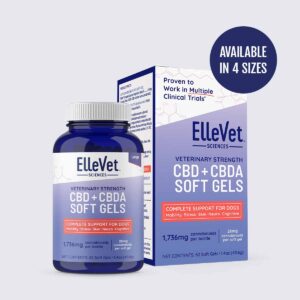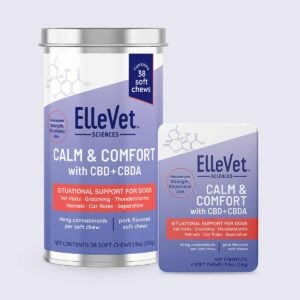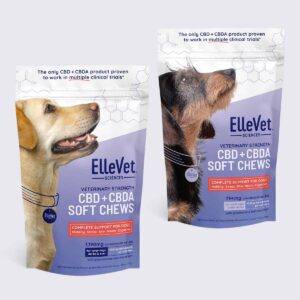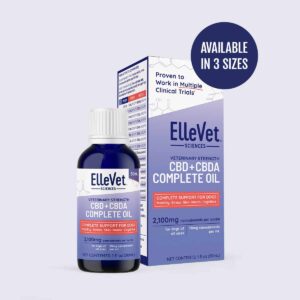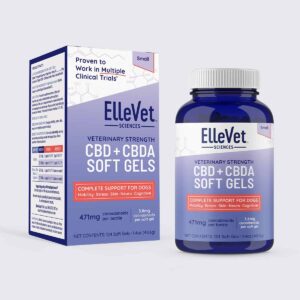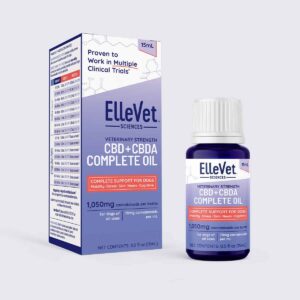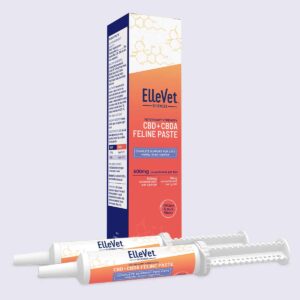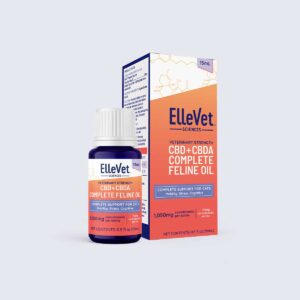CBD + CBDA for Pets Science and Research

ElleVet Leads The Way in Science and Research
CBD + CBDA Studies Conducted by ElleVet Sciences
Pharmacokinetics, Safety, and Clinical Efficacy of Cannabidiol Treatment for Joint Mobility in Dogs – July 2018
The objectives of this study were to determine basic oral pharmacokinetics and assess the safety and analgesic efficacy of a CBD + CBDA based oil in dogs with joint discomfort. Prof. Dr. Joe Wakshlag conducted the study at Cornell University College of Veterinary Medicine in 2017. The pharmacokinetic profile of CBD & CBDA and the clinical efficacy results suggest that 2 mg/kg of CBD + CBDA twice daily can help increase comfort and activity in dogs with joint discomfort). 75% of dogs in the study had a significant or dramatic positive response.
https://www.frontiersin.org/articles/10.3389/fvets.2018.00165/full
Copy and paste link into your web browser.
Single-Dose Pharmacokinetics and Preliminary Safety Assessment with Use of CBD-Rich Hemp Nutraceutical in Healthy Dogs and Cats – October 2019
This study examined the long-term safety and pharmacokinetics of ElleVet’s Proprietary Hemp CBD + CBDA blend on dogs and cats. The study was conducted in 2019 at The University of Florida Veterinary School under the direction of Dr. Deabold. This study showed that ElleVet hemp CBD + CBDA product is safe for dogs and cats and helped confirm the dosing for both species.
https://www.mdpi.com/2076-2615/9/10/832
Copy and paste link into your web browser.
Serum cannabidiol, tetrahydrocannabinol (THC), and their native acid derivatives after transdermal application of a low THC Cannabis sativa extract in beagles – July 2020
This study examined the pharmacokinetics of a transdermal product in comparison to an oral dose of ElleVet CBD + CBDA. It was conducted at The University of Florida Veterinary School by Dr. Joe Wakshlag in 2019 and published in 2020. The study lasted two weeks and showed that only trace amounts of THCA and unquantifiable amounts of THC are found in the serum after either form of administration of ElleVet’s CBD + CBDA Hemp extract. Furthermore, the study demonstrated that CBDA and THCA were absorbed better systematically than CBD or THC.
https://www.ellevetsciences.com/wp-content/uploads/2020/09/jvp.12896.pdf
Copy and paste link into your web browser.
Pharmacokinetics of Cannabidiol, Cannabidiolic Acid, Δ9-Tetrahydrocannabinol, Tetrahydrocannabinolic Acid and Related Metabolites in Canine Serum After Dosing With Three Oral Forms of Hemp Extract – September 2020
This study’s primary objective was to provide pharmacokinetic information on ElleVet’s hemp extract when presented in three different oral forms. Firstly, the researchers looked at how much THC, THCA, CBD, and CBDA were absorbed depending on the different formulations tested. Secondly, they assessed if 11-OH-THC, the major intoxicating metabolite of THC, could be found in the dog’s serum. Lastly, they analyzed the clinical pathology profile of all animals to evaluate the safety of the different formulations when administered twice daily for 2 weeks at the recommended dose of 2 mg/kg. This study was conducted between 2019 and 2020 at The University of Florida Veterinary School.
https://www.frontiersin.org/articles/10.3389/fvets.2020.00505/full
Copy and paste link into your web browser.
The Use of ElleVet Sciences Calm & Comfort Acute Strength CBD+CBDA Chews for Stress Inducing Events in Dogs – June 2020
We conducted a pilot study to evaluate canine response to anxiety-producing events after receiving our new Calm and Comfort chews. This study was conducted in 2020 at the Cornell University College of Veterinary Medicine, and the results showed that 83% (20/24) dogs had decreased stress or anxiety-related behaviors after when given ElleVet Calm and Comfort chews up to two hours prior to a stress-triggering event.
https://info.ellevetsciences.com/hubfs/CC_White_Paper.pdf
Copy and paste link into your web browser.
Cannabinoid, Terpene, and Heavy Metal Analysis of 29 Over-the-counter Commercial Veterinary Hemp Supplements – March 2020
We sourced 29 “hemp extract / CBD products for dogs” claiming to be made with low-THC Cannabis sativa extracts and sent blinded samples to a specialized and certified external laboratory for testing. All products were tested for major cannabinoids, major terpenes, and heavy metals to understand constituents in the hemp plants being extracted and distributed. This study was conducted in 2019 by scientists of the Cornell University College of Veterinary Medicine, ElleVet Science, and ProVerde Laboratories. Heavy metal contamination was found in 4/29 products, with lead being the most prevalent contaminant, 2 products had no cannabinoids in them and, of the remaining 27, only 10 were within 10% of the total cannabinoid concentrations of their label claim.
https://www.dovepress.com/cannabinoid-terpene-and-heavy-metal-analysis-of-29-over-the-counter-co-peer-reviewed-article-VMRR
Copy and paste link into your web browser.
Single Dose and Chronic Oral Administration of Cannabigerol and Cannabigerolic Acid-Rich Hemp Extract in Fed and Fasted Dogs: Physiological Effect and Pharmacokinetic Evaluation – February 2022
The use of cannabinoids for pets has seen extraordinary growth over the past 5 years, and much attention and research has been focused around the use of CBD, but little has been researched regarding the acidic forms of the molecules. Until this study there were no research or papers on CBG or CBGA, which is surprising since CBG is the precursor molecule to cannabinoid formations in the plant. This study investigates similar dosing of CBG and CBGA to better understand absorption and retention of these cannabinoids in dogs. Key takeaways of the study show that CBGA is absorbed 40 fold better than CBG in both fed and fasted states and no differences in serum concentrations were observed between states. Importantly, no adverse events, determined by physical exams, complete blood counts and serum chemistry evaluations were observed. While more research is needed, CBGA is more absorbable and retains serum concentrations for a greater length of time making is more likely to have pharmacological benefits.
https://www.ellevetsciences.com/wp-content/uploads/2022/04/Vet-Pharm-Therapeutics-2022-Amstutz-Single-dose-and-chronic-oral-administration-of-cannabigerol-and-cannabigerolic.pdf
Copy and paste link into your web browser.
The effect of a mixed cannabidiol and cannabidiolic acid based oil on client-owned dogs with sensitive skin – May 2022
The purpose of this study was to determine if CBD/CBDA is an effective therapy for canine sensitive skin. Thirty-two privately owned dogs with refractory sensitive skin were enrolled from the Animal Dermatology and Allergy Service in the greater New York Area. After fulfilling inclusion criteria a prospective, randomized, double-blinded, placebo-controlled study was performed. Dogs were randomly assigned to receive either 2 mg/kg of an equal mix of CBD/CBDA rich hemp from ElleVet Sciences (n = 17) or placebo for four weeks. Concurrent therapies were allowed if remained unchanged during the 4 weeks. The results showed that 65% of dogs in the study had a 50% or greater reduction in itching and 50% of those had a complete cessation of itching.
https://onlinelibrary.wiley.com/doi/10.1111/vde.13077
Copy and paste link into your web browser.
Safety and efficacy of cannabidiol-cannabidiolic acid rich hemp extract in the treatment of neurological events in dogs – July 2022
The objectives of this study were to determine the safety and efficacy of cannabidiol-cannabidiolic acid rich hemp extract in the treatment of neurological events in dogs. The results showed 40% of dogs had a 50% or greater reduction in neurological events over a 12 week period.
https://www.frontiersin.org/articles/10.3389/fvets.2022.939966
Copy and paste link into your web browser.
Twice-daily oral administration of a cannabidiol and cannabidiolic acid–rich hemp extract was well tolerated in orange-winged Amazon parrots (Amazona amazonica) and has a favorable pharmacokinetic profile – February 2023
A study was conducted on orange-winged Amazon parrots with twice daily for 7 days administration of a full spectrum hemp extract with known CBs concentrations. This twice daily oral administration was well tolerated and resulted in target plasma concentrations without adverse effects at a dose based on 30/32.5 mg/kg of CBD/CBDA. Although there are similarities with mammal pharmacokinetic parameters, this study suggests that avian species could have differences in the cannabinoid metabolic pathway than mammals.
https://doi.org/10.2460/ajvr.22.11.0197
Copy and paste link into your web browser.
Cannabidiol and cannabidiolic acid: Preliminary in vitro evaluation of metabolism and drug-drug interactions involving canine cytochrome P-450, UDP-glucuronosyltransferase, and P-glycoprotein – July 2023
This study examined CBD + CBDA’s metabolism and potential drug-drug interactions involving canine cytochrome P-450 metabolism, UDP-glucuronosyltransferase conjugation, and P-glycoprotein drug efflux influences. The study, led by Dr. Michael H. Court of Washington State University, showed that CBD + CBDA are each metabolized differently in dogs, with P450 enzymes, particularly CYP1A2 and CYP2C21, playing a major role with CYP1A2 being the likely primary metabolizer of CBD. This is the first publication to suggest that CBDA skips the first step of the biotransformation and is directly glucuronidated (the glucose like molecule) on the carboxylic acid that makes CBD different from CBDA. According to pharmacokinetic profiling, this seminal publication suggests that at physiological concentrations achieved in the dog, significant inhibition of the tested cytochrome p450 enzymes is unlikely.
https://onlinelibrary.wiley.com/doi/10.1111/jvp.13403
Copy and paste link into your web browser.
The Case for Cannabigerol Dental Sticks for Oral Health in Dogs – March 2024
Chew style dentifrices like the ElleVet Dental Stick leverage mechanical action on the tooth surface to reduce plaque accumulation in dogs. Bite force testing confirms that the ElleVet Dental Stick has optimal density to allow for maximum abrasive action on tooth surfaces to decrease plaque accumulation. The inclusion of CBG aids in limiting bacterial growth and plaque formation. Most importantly, digestibility safety has been proven with the ElleVet Dental Stick showing over 80% digestibility in stomach and small intestinal assays, allowing us to provide a safe and effective dental stick.
https://www.ellevetsciences.com/wp-content/uploads/2024/07/EV_WHITE-PAPER_Dental-Stick.pdf
Copy and paste link into your web browser.
Pharmacokinetics and tolerability of single-dose enteral cannabidiol and cannabidiolic acid rich hemp in horses – April 2024
This study aimed to determine the pharmacokinetics and tolerability of 2 mg/kg and 8 mg/kg dose of CBD/CBDA-rich hemp product after a single-dose enteral administration. Each horse was administered 2 mg/kg or 8 mg/kg or no treatment in a randomized cross-over design. Serial serum samples were collected over 48 hours and plasma chemistry analysis were performed and vital parameters, pedometry, and blinded mentation and gait evaluations were recorded. Manure production and gastrointestinal transit time were tracked for 48 h after oil administration. The median maximal concentration of CBD and CBDA were 5.2 and 36.95 ng/ mL in the 2 mg/kg group, respectively; and 40.35 and 353.56 ng/mL in the 8 mg/ kg group. No significant differences in any of the measured tolerability parameters were demonstrated between treatment groups. Single-dose enteral administration of CBD/CBDA-rich hemp extract up to 8 mg/kg does not appear to produce neurologic, behavioral, or gastrointestinal effects in horses.
https://www.frontiersin.org/journals/veterinary-science/articles/10.3389/fvets.2024.1356463/full
Copy and paste link into your web browser.
Tolerability of 2 and 4 mg/kg Dosing Every 12 Hour of a Cannabidiol- and Cannabidiolic Acid-Rich Hemp Extract on Mixed-Breed Dogs Utilized for Teaching in a Closed Colony – June 2024
This study aimed to examine the effects on dogs when using a 2 mg/kg and 4 mg/kg dose of CBD/CBDA-rich hemp product every 12 h in an academic teaching colony of dogs when compared to the consumption of a placebo soft-gel capsule every 12 h for two weeks. The results indicated that although there were serum concentrations of CBD in the 30–100 ng/mL concentration and 100–200 ng/mL concentration of CBDA, there were no adverse effects or behavioral changes observed regardless of the treatment used, thus showing that in normal healthy dogs, 2–4 mg/kg every 12 h appears to a safe dosing regimen.
https://www.ellevetsciences.com/wp-content/uploads/2024/06/animals-14-01863.pdf
Copy and paste link into your web browser.
Pharmacokinetics and safety of chronic oral dosing of cannabidiol and cannabidiolic acid full spectrum hemp oil extracts in horses – January 2025
The aims of this study were to determine the safety of chronic administration of CBD and CBDA and compare the pharmacokinetics in horses over 6 weeks. Both CBD and CBDA rich oils (1mg/kg) were administered orally twice daily over 6 weeks in a randomized crossover design. A 12-hour pharmacokinetic was conducted on day 1 of each 6-week trial and the cannabinoids safety was assessed via daily physical exam, periodic bloodwork, and liver biopsy at the beginning and end of the study. Results showed peak serum levels of CBDA were higher than CBD 103 vs 12 ng/mL as well as a greater AUC of 259 vs 62 ng-hr/mL. There were no clinically relevant serum chemistry changes for CBD or CBDA nor abnormalities in the liver. The clinical relevance of this study is that chronic supplementation of CBD and CBDA at 1mg/kg in healthy horses is safe and considering the higher absorption of CBDA, its use is recommended to evaluate therapeutic efficacy of cannabinoids.
https://avmajournals.avma.org/view/journals/ajvr/aop/ajvr.24.08.0235/ajvr.24.08.0235.xml
Copy and paste link into your web browser.
The ElleVet Advantage: Science First
The science behind hemp CBD + CBDA
All mammals have an endocannabinoid system (ECS) which is one of the oldest systems in the mammalian body and is responsible for maintaining homeostasis, or balance. Whatever is not functioning as it should, whether that be an inflammatory response, a cognitive issue, or a digestive issue is brought back into balance by the ECS. Cannabinoid receptors are found throughout the brain and body and are activated when CBD + CBDA, terpenes, and the smaller cannabinoids are introduced in the body.
Receptors
A widely held belief is that the CB1 and CB2 receptors are the receptor systems involved in processing cannabinoids. Go to any CBD company website and you will see a diagram of the CB1 and CB2 receptors in the body of a dog or cat. This is outdated and incorrect information! ElleVet’s research has shown that it is far more complex and that the receptors involved include the TRP, GPR, PPAR-g GPR55, 5HT, glycine, and adenosine uptake receptors. Read on to hear more about the receptor systems.
Terpenes
Terpenes are additional compounds found in the hemp plant and are best known for their smell. However, they are important in other ways, such as promoting calm or helping with an anti-inflammatory response. Terpenes work together with cannabinoids to work synergistically to create an overall better effect, which is called the entourage effect. ElleVet’s proprietary blend contains a robust terpene profile that contributes to the incredible effectiveness of the ElleVet family of products.
Why Hemp CBD + CBDA?
There is any number of products available that have been developed to help pets, and it can be hard to decide which is going to help your pet the most and which is the safest. It comes down to those two criteria and often a pet owner has to make the difficult choice of help over safety. We are changing this, so pets and pet parents can have both safe and extraordinary results.
Hemp CBD + CBDA has made a profound impact on veterinary medicine in the past 5 years and has changed the way veterinarians and pet parents think about managing discomfort, stress, itching, cognition, tremors, and many other issues.
Becoming the first line of defense is what we at ElleVet have as a goal so that pets can receive the benefit and safety of hemp CBD + CBDA first, and not as a last-ditch effort. We have proven that our CBD + CBDA product works better than so many other, traditional options, and is extremely safe for pets. We hope ElleVet will soon become the first product that veterinarians reach for, and we believe our research and understanding of cannabinoids and the Endocannabinoid System will help us create better and better products for pets.
What is the Endocannabinoid System?
The endocannabinoid system (ECS) is an important system in the body of every mammal. The ECS is one of the largest receptor systems in the body. It functions both as an immunomodulatory and a neuromodulatory system and is essential for stress recovery as well as maintaining homeostasis in the body, or making sure everything is in balance. There is virtually no physiological or cognitive process that isn’t related in some manner to the ECS.
The ECS is composed of endogenous lipid-based signaling molecules which bind to cannabinoid receptors. The body has many important systems that appear to be affected by “endocannabinoid tone” with the most work being done at understanding the endocannabinoids in the central nervous system and the immune systems. Somehow, the endocannabinoid system was unknown, overlooked, and generally not a part of the medical or veterinary school curriculum due to a lack of research in clinical patients, which explains why healthcare providers have not taken advantage of the vital role cannabinoids play in maintaining balance in the body.
Simply put, whatever is out of balance, whether it be itching, an inflammatory response, discomfort, cognitive issues, the endocannabinoid system’s job is to address the imbalance and get back to normal. There is still much to be learned about the ECS and the full extent of its role, but understanding the function of the ECS is needed to understand how cannabinoids help to maintain a healthy body and mind. There are 3 parts to the ECS, which are endocannabinoids made by cells of the body, the receptors that these endocannabinoids bind to, and the enzymes that make and degrade these endocannabinoids in the body.
The Functions of the Endocannabinoid System
Perception of discomfort.
The body has a central nervous system and a peripheral nervous system which release excitatory and inhibitory neurotransmitters signaling discomfort, tremors, and spasticity. Often when imbalanced there is a preponderance of excitatory neurotransmitter release. The ECS is able to re-balance the release of these excitatory transmissions and therefore reduces the body’s responses. This is helpful to understand why certain conditions involving spasms respond favorably to cannabinoids.
Inflammatory response
The Endocannabinoid System is able to modulate the inflammatory response by downregulating the production of inflammatory proteins and chemotaxis of inflammatory cytokines by macrophages or mast cells (for example). Modulating the inflammatory response is important in controlling conditions from joint discomfort to allergic reactions, and countless other circumstances.
How do Cannabinoids work with the Endocannabinoid System?
Cannabinoid receptors are G coupled protein receptors found throughout the body and brain, and cannabinoids, particularly the exogenous hemp-derived cannabinoid THC will bind with and stimulate these receptors. The body produces its own cannabinoids, called endocannabinoids, which are the endogenous lipids, anandamide and 2-AG are the primary endocannabinoids Anandamide is also known as the bliss molecule, and these are ligands for the cannabinoid receptors and will activate the receptors in order to maintain tight control of bodily functions.
One example might be that when a body is overheated and sweating begins, that is the ECS regulating temperature. When phytocannabinoids, or cannabinoids from a plant such as hemp, are added, it is bringing in extra help to regulate and rein in whatever is out of balance by further activating the appropriate cannabinoid receptors. Interestingly, only the proper receptors are activated to address the specific issue, such as overheating, and other functions in the body are not subjected to overstimulation. This is helpful in understanding how CBD products such as ElleVet, can address multiple issues such as discomfort, stress, or cognitive issues.
Endocannabinoid System Receptors
ElleVet’s understanding of the mechanism of how CBD + CBDA interacts with the body is constantly expanding and deepening. This has led to new and groundbreaking understanding of the receptor systems involved, which are far more complex than previously thought, and do not involve the CB1 or CB2 receptors. As a whole, they are referred to as the endocannabinoidome. The activation of the endocannabinoidome protects the body from a wide variety of imbalances.
It has been proven that CBD may be an allosteric inhibitor of the CB1 and CB2 receptors but only at a concentration level that would not be achievable or relevant. Many receptor pharmacology studies have been performed and based on the serum concentrations that can be achieved it is very unlikely that these receptors play a role. There is a growing consensus that other receptor systems including transient receptor potential channels, serotonin receptor, g protein orphan receptors (GPR55), glycine receptor, peroxisomal proliferator-activated receptors and adenosine transport channels may play a far more significant role in the CBD and CBDA response that previously thought. Discomfort mitigation, the anti-inflammatory effect, overall sense of wellness, neuro support, anti-nausea and anti-vomiting are all regulated by CBD and CBDA interactions with these receptor systems and channels with CBDA having a key role, particularly in the anti-inflammatory and serotonin response.
Exactly what do these receptor systems do? It turns out that the receptor systems that are CBD or CBDA targets begin with the transient receptor potential channels, or TRP family of channels. This family of ion channels are affected by CBD because of the high affinity at concentrations that, based on channel pharmacology, are activated and desensitized at what we feel are pharmacologically achievable concentrations based on our pharmacokinetic studies.
These TRP receptors are important in the peripheral and central nervous systems for detecting discomfort stimuli and the binding of CBD + CBDA to these receptors activates and eventually desensitizes the channels thereby dampening sensation transmission and perception.
Other receptor groups such as the g protein orphan receptors (GPR), glycine, peroxisomal proliferation gamma (PPAR-g) and adenine receptor systems have historically been poorly studied but have been found to be influenced by CBD and CBDA. GPR55 and glycine are involved in neuronal signaling and depolarization, where GPR55 may regulate depolarization when activated by endogenous cannabinoids. CBD is an antagonist of this receptor. Conversely, when the glycine receptor is activated, it allows for repolarization due to an influx of chloride, causing hyperpolarization of the neuron, which supports physical comfort.
The PPAR-g receptor is an intracellular receptor that influences transcription and translation of genes that are usually involved in cytokine production in immune cells leading to global dampening of the inflammatory response in macrophages and histocytes.
As far as neurological issues, CBD and CBDA seem to interact at the adenosine receptor/equilibrate nucleotide transporter leading to alterations in glutamatergic signaling and calming neuronal excitability, thereby reducing neuro activity.
Finally, the 5HT1A receptor and the 5HT3A receptor, which are both serotonin receptors that are influenced by CBD as an agonist to promote both serotonergic stimulus and homeostasis around serotonin signaling, promoting a feeling of happiness and overall wellness. Interestingly CBDA has a higher affinity for these receptors and has been shown to be even more effective than CBD regarding nausea and appetite.
Lastly, there is also evidence that CBD and CBDA allow for inhibition of the enzymes that break down the natural ligands to CB1 and CB2 receptors. This may allow for higher synaptic concentrations of these natural ligands, therefore indirectly CBD and CBDA may influence CB1 and CB2 receptors through obtuse indirect mechanisms.
Enzymes
The third component of the ECS, along with endocannabinoids and receptors, are enzymes. Enzymes function to break down Anandamide and 2-AG so that overstimulation of the receptors does not occur, therefore assisting in maintaining balance. However, CBD or cannabidiol can inhibit anandamide breakdown by inhibiting the enzyme FAAH, or fatty acid amidohydrolase, which in turn can prolong and enhance its positive effects.
ECS Tone
ECS tone is essentially the baseline level of endocannabinoids (anandamide and 2-AG) in the body and the density and functioning of the cannabinoid receptors. When an ECS is working optimally, the body is in a state of physical and emotional balance, and when it is overactive or underactive, and therefore out of balance, the body reacts accordingly.
An overactive ECS could manifest in inflammation, obesity, or diabetes. An underactive ECS can manifest as more severe IBS, migraines, or mood imbalance for example. Therefore the tone or the baseline state of health and balance of the ECS itself is a key to good health and wellbeing and has become a subject of great interest in terms of both addressing existing issues and boosting healthy “ECS tone” with a daily intake of cannabinoids.
Should CBD be taken daily for ECS Tone support?
In theory, taking CBD + CBDA daily would exercise the ECS and help create a healthy baseline or tone. Physical exercise and other positive lifestyle choices are thought to boost ECS tone and it would make sense that taking CBD daily would achieve the same type of effect.
Daily CBD as a prophylactic measure is gaining popularity as the idea of helping the ECS to prevent conditions before they manifest is appealing. It is an area of great potential although further research is needed to determine the efficacy of this approach and the appropriate dosing. Would putting a younger dog on a moderate dose of CBD + CBDA daily help to keep them happy and healthy longer? Many pet owners believe so and any young dog with stress or itching that uses CBD + CBDA already could see long-term benefits in other areas which is an exciting new avenue of exploration in veterinary medicine.
What are Terpenes?
Terpenes are compounds found in hemp along with cannabinoids. Terpenes are mainly known for their scent, as they are what causes the distinctive hemp smell, although they are also responsible for other scents like lavender, hops, citrus, or pine. However, terpenes contribute more to hemp than just smell. They have potent anti-inflammatory properties, calming properties and can aid in sleep, respiration, and many other areas, so they are an important part of a full spectrum CBD + CBDA product. A good product will have a robust terpene profile, and the terpenes and cannabinoids work together in a synergistic way called the entourage effect. The entourage effect is essentially that each individual part is enhanced by the sum of the parts. Some of the most abundant terpenes are
- Myrcene – the terpene usually present in the largest quantity, it is known for its anti-inflammatory properties. It is also volatile and care needs to be taken during the extraction process so that it doesn’t evaporate.
- Limonene – as the name indicated, it has a lemony smell and is often used in cleaning or cosmetic products. It is known for its calming properties.
- Alpha pinene – a pine tree smell and known for anti-inflammatory properties and for respiratory relief
- Beta-caryophyllene – a peppery smell, this terpene is known for anti-stress and anti-inflammatory properties
- Humulene – an earthy smell and is also found in hops. This is thought to aid in memory and memory retention.
- Linalool – this terpene is best known for its hemp smell and is also known for its calming and sedative properties
Terpenes are an important part of a good CBD + CBDA product and a strong smell, even if your pet might not appreciate it, can indicate a high-quality product. Currently, we have little evidence that the amounts found in CBD products have true clinical effects, but more importantly, besides the potential entourage effects, these terpenes act as natural anti-oxidants in our products to help with maintaining the long shelf life of our products.
This is how our CBD + CBDA works
Putting it all together, this is how ElleVet CBD + CBDA helps your pet:
There are complex explanations about the Endocannabinoid System, about the different components of the ECS and how your pet’s body responds to CBD, and many other scientific explanations regarding the use of CBD + CBDA. As a pet owner, what you really want to know is if CBD + CBDA is going to work for your pet, it is safe for your pet, and why it should be the product that you choose over all the other options.
When your senior pet is uncomfortable due to age-related joint issues, mental decline, and also has musculoskeletal problems like tremors you know your dog is uncomfortable and not experiencing a good quality of life. His endocannabinoid system is trying to address these issues and bring his body back to a state of comfort and balance but is unable to achieve this.
You go to your veterinarian to discuss options to make your pet comfortable and happy, and she might suggest several different products to address his multiple issues, which come with potentially serious side effects and may or may not work. Your veterinarian also suggests taking ElleVet full spectrum CBD + CBDA which has been proven safe and proven to work in clinical trials. You decide to give your pet our recommended dose. Immediately the CBD + CBDA activates the ECS receptors in his body and his ECS is now able to lessen the perception of discomfort, lessen the excitatory process that causes tremors, improve mental acuity, and able to down-regulate the inflammatory response so your pet feels much better. This all occurs so quickly that in a matter of 2-5 days you see a noticeable improvement in comfort, happiness, and overall quality of life without side effects.
It’s science, it’s not magic, and your dog is suddenly bounding up the stairs or brings an old toy out to play with that you have not seen in years. This is because we have spent nearly 5 years on research to make sure your dog is getting the optimal dose, proper frequency of administration, and combination of cannabinoids and terpenes to give your dog a happy and healthy life because we think all pets deserve the best.
